“Capitalists make money by exploiting labor and by externalizing the costs of the wastes produced by the productive process by imposing the wastes on the environment.”
Paul Craig Roberts
Waste: Types, Causes, Effects & Solutions
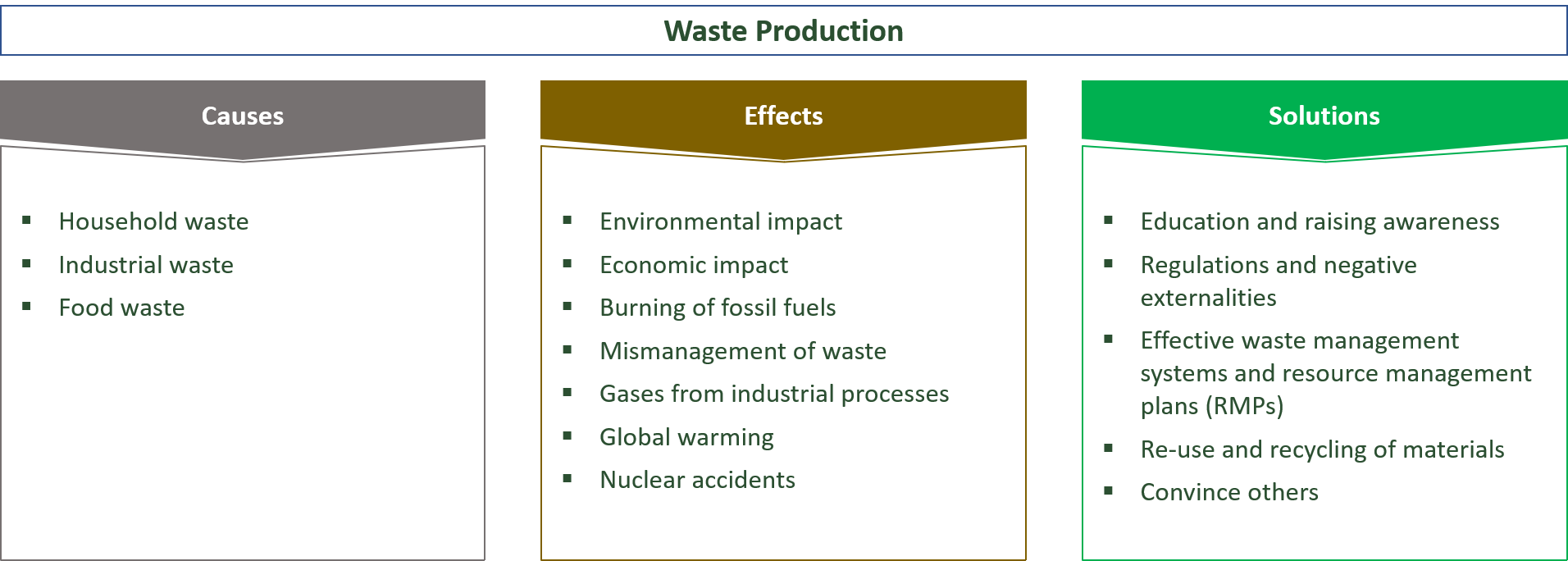
Waste can be determined as unusable or unwanted materials.
It is usually worthless, defective and/or discarded after primary use.
It can be divided into two major categories, household waste and industrial waste.
Both household and industrial waste can pose serious dangers to the environment and thus should be handled with great care.
Audio Lesson
Contents
Types of Waste
- Solid waste
- Liquid waste
- Organic waste
- Hazardous waste
- Recyclable waste
Solid waste
Solid rubbish includes ceramics and glass, plastics, paper waste as well as metal waste.
It can be found in households as well as in industrial processes.
Liquid waste
Liquid waste includes wash water, dirty water, rainwater, water detergents and so on.
It is produced by all kinds of entities, including private households and industries.
Organic waste
Organic waste includes garbage from vegetables and fruits as well as all garbage material that can be turned into manure with the support of microorganisms.
You should separate organic waste from your conventional waste in order to make it available for reuse by industries.
Hazardous waste
Hazardous waste usually refers to garbage that can pose serious threats to the environment.
This usually includes waste that is either toxic, flammable, reactive or corrosive.
This sort of waste has to be disposed of with great care in order to ensure safety for our environmental system.
Recyclable waste
Recyclable waste includes all waste items that can be recycled and then reused for other purposes.
Recyclable garbage usually includes solid waste items like metal waste or paper.
Recyclable rubbish has to be separated from your other household waste in order to be used for recycling.
It is therefore crucial that you put in effort in order to separate your waste properly.
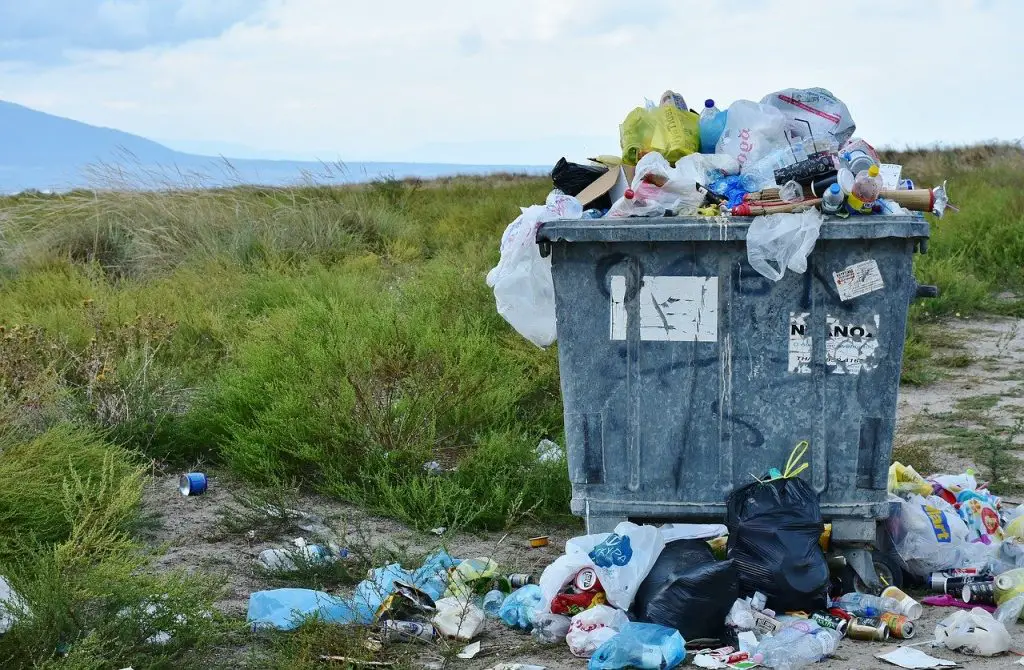
Causes for Waste
- Household waste
- Industrial waste
- Food waste
Household waste
Household waste is post-consumer waste which includes consumer products, home care products, personal care products, automotive care products, household chemicals and more.
With the expansion of the world population, the amount of household waste increases dramatically.
Moreover, consumer behavior changed over time which resulted in even more waste production.
Examples for that are the increasing number of online purchases.
Items purchased online need more wrapping as if bought in a normal store.
Additionally, people return their products quite frequently which causes even more garbage since in many cases, not only the wrapping has to be renewed, even the product itself will be disposed of due to economical or regulatory reasons.
At first glance, consumer waste sounds not as dangerous as industrial waste when it comes to potential adverse effects on our environmental system.
However, household waste can be quite harmful since many products of daily life contain chemicals that can cause an adverse ecological impact if not disposed of appropriately.
In fact, some of these products have many of the same dangerous characteristics as regulated hazardous waste due to their ability for ignitability, reactivity, corrosivity, persistence and toxicity.
Examples include motor oil, fuel, medical waste, cleaning chemicals, consumer electronics and batteries.
Industrial waste
Industrial waste can be defined as the waste caused by industrial activities including waste which is rendered useless during manufacturing.
This includes masonry and concrete, dirt and gravel, scrap metals, oil, chemicals, solvents, scrap lumber and additional garbage items produced by factories, mills and industries.
It may appear in liquid, gaseous or solid form. Industrial waste can be radioactive, toxic, corrosive, ignitable or reactive.
It can lead to the pollution of soil, air and water.
Food waste
Large amounts of food are produced every day.
However, a big fraction of this food is disposed of even before it reaches our grocery stores.
This may be due to minor issues.
For example, if a cucumber has too much curvature, it is regarded as not suitable for our grocery stores and therefore is treated as garbage.
This is not only true for cucumbers but also for many other food items.
This behavior leads to a huge waste of resources since the food would be suitable for consumption.
It is just thrown away because of its unaesthetic physical appearance.
Moreover, even if the food reaches our grocery stores and people buy it, a significant fraction of our food ends up in the garbage since we do not consume it.
In addition, many people are afraid to consume food if the best before date is reached even if the food still is in good shape and not dangerous to human health.
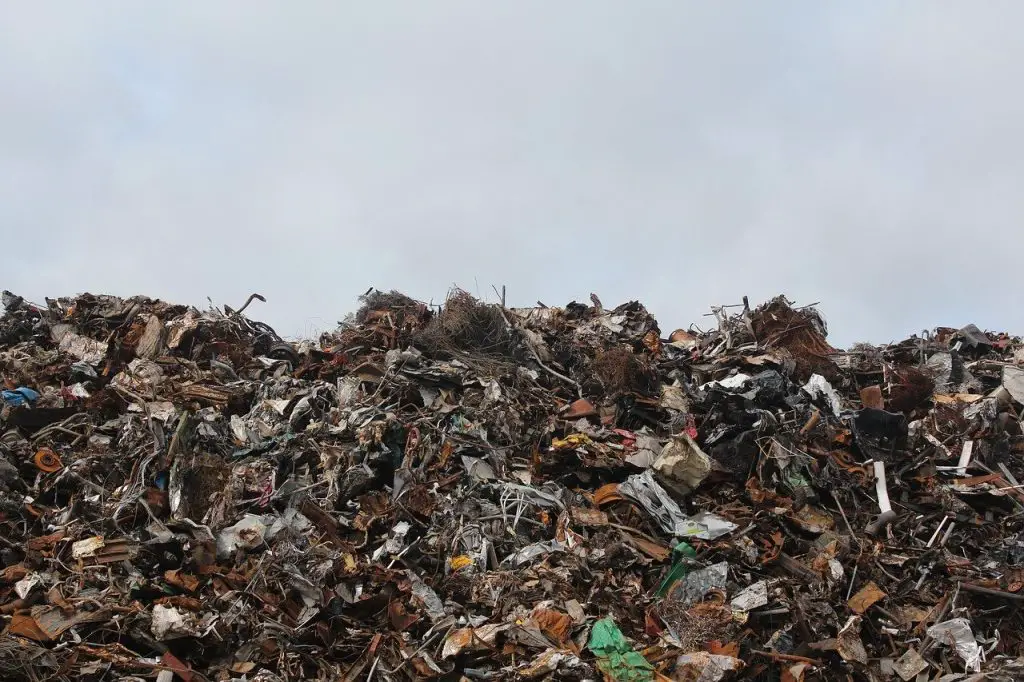
Effects of Waste
- Environmental impact
- Economic impact
- Burning of fossil fuels
- Mismanagement of waste
- Gases from industrial processes
- Global warming
- Nuclear accidents
Environmental impact
If waste is not disposed of appropriately, it can attract insects and rodents, which in turn can harbor parasites, worms, yellow fever, the plague and other serious conditions for humans.
Also, there is a big risk for cancer if humans are exposed to hazardous waste which is burned without sufficient protection.
Toxic waste can pollute groundwater, soil, surface water and air which can cause many problems for humans as well as for environmental health.
Moreover, gases like CO2 and methane, which are a by-product in many production processes, have an adverse impact on our environment since these gases increase the speed of global warming.
Economic impact
There are large economic costs related to managing and appropriate disposal of waste.
The long-term consequences may even be more dramatic than short term issues.
For example, the inappropriate disposal of nuclear waste may cause huge environmental problems in the future since the short-term solutions for this issue do not take into account the long-term consequences appropriately.
Burning of fossil fuels
In order to be able to get rid of the huge amounts of waste which are produced every day, significant amounts of fossil fuels have to be burned in this process.
The use of fossil fuels will in turn lead to air pollution and will also increase the speed of global warming since many harmful greenhouse gases will be produced in the combustion processes.
Mismanagement of waste
In order to get rid of waste in a proper way, there have to be effective waste disposal processes in place.
If there is a lack of proper processes, mismanagement of waste may be the result.
This could mean that waste is not disposed of in landfills or burned but rather it is just disposed of illegally in forests or lakes.
This mismanagement can lead to serious pollution of the environment and therefore can adversely affect many animals and plants.
Gases from industrial processes
There are several harmful gases that are released in the burning process related to waste disposal.
These gases may lead to acid rain.
Moreover, they may also contribute to the global warming issue.
Especially gases like CO2 and Methane are known to be quite harmful greenhouse gases.
Global warming
Through our consumption behavior and the resulting great amounts of waste, the global warming process is enhanced in a dramatic way.
On the one hand, the production of goods leads to the emission of greenhouse gases.
On the other hand, also the disposal of waste leads to the emission of greenhouse gases through combustion processes.
Thus, through our excessive consumption levels, we indirectly contribute to an increased speed of global warming and its resulting consequences.
Nuclear accidents
Nuclear energy is one of the biggest sources of energy production in our nowadays technological society.
In order to get rid of nuclear waste, extreme safety measures have to be taken.
Accidents with nuclear waste could contaminate large areas of land.
Moreover, the incorrect disposal of nuclear waste could also harm many animals, plants and even humans.
Making things worse, nuclear waste usually takes quite a long time to lose its harmful compounds.
Thus, if nuclear waste is not disposed of properly, the contaminated areas will be useless to humanity for a quite long period of time.
Waste Disposal
Waste disposal can be defined as destroying, storing or getting rid of unwanted industrial, domestic or agricultural products.
It can be seen as an action plan to manage waste in a systematic way.
This may include burning, the usage of landfills or discharging waste in oceans, lakes and rivers, which may lead to ocean pollution and other issues.
Moreover, recycling can be a useful and environmental-friendly way to get rid of waste and reuse it for useful products.
However, in practice, there are several issues related to the waste disposal process.
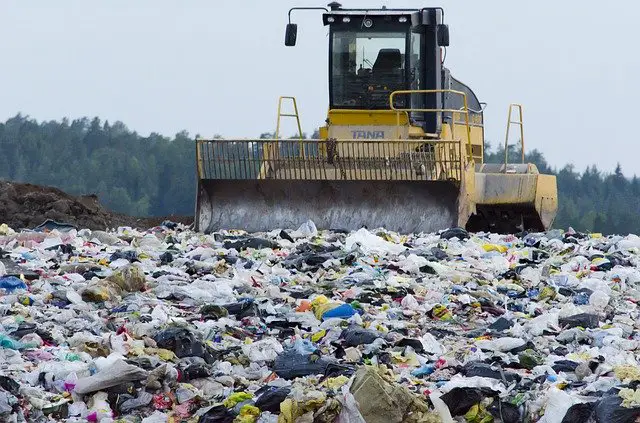
Waste Disposal Problems
- The amount of waste is simply too big
- Toxicity of waste
- Landfills are a problem as well
- Public vs. private interest
- Missing consensus about the best waste management strategies
- Ineffective long-term waste disposal strategies
The amount of waste is simply too big
According to the world bank, the world generates 2.01 billion tons of municipal solid waste a year, with at least 33 percent not managed in an environmentally safe manner.
This implies that the worldwide waste generated by an average person amounts to 0.74 kg.
Also, high-income industries generate more waste per person than developing countries.
According to the world bank, in 2050, global waste is expected to amount to 3.4 billion tons a year.
The total generated waste in low-income countries is expected to increase by over three times by 2050.
This enormous increase in low-income countries is due to the fact that waste production is positively correlated with income.
Low-income countries eventually will get richer, thus GDP per person is likely to increase.
As a result, consumption levels and therefore trash production will increase.
Another problem can be attributed to our behavior when it comes to consumption.
People always need the newest iPhone, the hippest clothes, a new car and so on.
Even when things are still functional, people will throw them away in large amounts to get the newest version.
This attitude towards material things is eventually becoming a huge problem since for the production of all these goods, we have to deplete more and more resources and waste production is a serious adverse by-product of this consumption attitude.
Toxicity of waste
Toxic waste can be the result of chemical, biological or industrial processes.
It can also be found in offices or even households.
Typical household articles that may result in toxic waste include pesticides, computers, cell phones and batteries.
The handling of toxic waste is a huge worldwide problem.
In countries with low regulatory interventions, polluters have not a big incentive to dispose of toxic waste in a responsible manner.
Thus, toxic waste is often disposed of into rivers, lakes or the ocean.
In countries with strict regulatory standards, toxic waste is sometimes dumped illegally.
Many developed countries also send their toxic trash to developing countries in order to get rid of it.
In these developing countries, people lack the expertise to handle this toxic waste safely, which may result in health problems for the local population.
Landfills are a problem as well
A landfill is a method for depositing waste in specially constructed protected cells.
Landfills still play an important role in waste management strategies, despite the fact that more and more waste is reused or recycled.
The problem with landfills is that they result in the production of gases and leachate which can cause problems to human health.
Since these gases consist mainly of methane and carbon dioxide, they also contribute to climate change.
Additionally, landfills also emit other gases which in some cases are even toxic.
Moreover, the leachate can reach the surface or groundwater and thus hurt the environment. Additionally, the construction of new landfills may impact the environmental surroundings in an adverse way.
Also, people who are living close to landfills are complaining about smoke, flies, odors and noise and thus are impacted in a negative way.
Public vs. private interest
Public and private interests usually diverge if it comes to the protection of the environment.
On the one hand, private companies try to maximize profits and usually don’t care too much about adverse negative externalities on the environment.
On the other hand, it is in the public interest to save and conserve nature and our ecosystem.
Thus, it is necessary for regulatory authorities to impose strict rules of conduct on industries in order to ensure economic sustainability.
The problem is that even governments are largely influenced by the big companies.
Big companies are lobbying for an excessive depletion of resources at the cost of environmental health.
Some governments are corrupt and thus accept the depletion of the resources in their country if they can also benefit from the financial upside.
This leads to excessive depletion of resources and an enormous amount of waste produced globally.
Missing consensus about the best waste management strategies
In the discussion for finding optimal waste management strategies, there is little consensus on which strategy actually makes sense and which should be abandoned.
For example, electric cars are officially considered as „green“, but the production and recycling of the batteries still poses a big source of trash.
Moreover, also in the discussion of waste management strategies, companies have an incentive to lobby for their interests in order to increase their profits which may diverge from public interest.
Ineffective long-term waste disposal strategies
Many countries are simply overwhelmed and are not able to manage trash in an appropriate manner.
Therefore, these countries often use short-term methods to get rid of their trash, while not taking into account the long-term consequences of their actions.
Moreover, especially in developing countries, technologies for waste disposal are far less advanced than in developed countries.
This leads to inefficiencies in the trash disposal process.
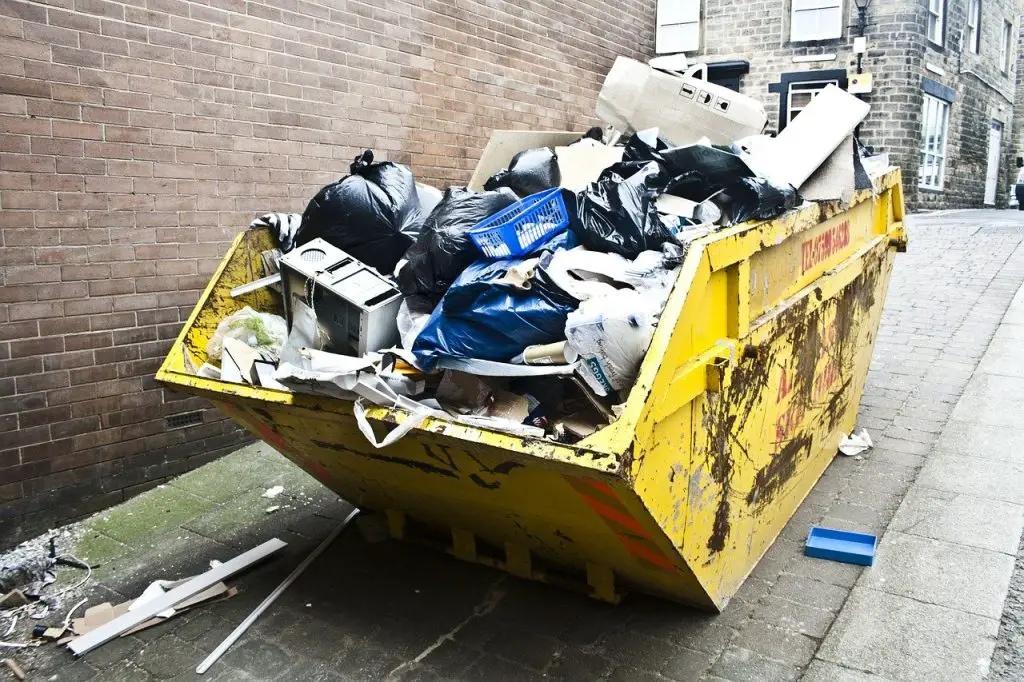
Solutions for the Waste Problem
- Education and raising awareness
- Regulations regarding negative externalities
- Effective waste management systems and resource management plans
- Re-use and recycling of materials
- Convince others
Education and raising awareness
In order to solve the issue of waste, we have to educate people on how their daily life habits adversely affect the environment.
This has to start early in school as part of the obligatory subjects like math or geography.
People have to get aware of what they are doing, what consequences their actions have for other people and the environment and how to improve their behavior.
For example, coffee to go is so popular in our society now.
Yet, the number of cups thrown away after just one usage is dramatic.
Paying attention to this small detail and stop using disposable cups would reduce the waste problem quite a bit.
There are several more things to do in our daily lives in order to reduce garbage which is not hard at all.
People are just convenient and do not care about it.
We have to raise awareness of this issue in order to reduce the amount of waste.
Regulations regarding negative externalities
If people are too convenient or not willing to reduce their garbage, there should be interventions by governments or local communities.
This could be a scheme in which sustainable behavior is acknowledged and harmful behavior is punished.
This could be in the form of financial upside through the form of reduced taxes for good environmental behavior and increased taxes for harmful economic behavior.
This system should also be valid for industries.
If an industry imposes negative externalities on the environment, this should result in financial compensation for the community.
With this approach, firms would have a big incentive to develop economical-friendly systems and to reduce their adverse impact.
Effective waste management systems and resource management plans
An effective waste management system is crucial for sustainable economic and ecological development.
However, the waste management system should be used in conjunction with a profound resource management plan (RMP).
An RMP is part of an integrated material management plan, in which a municipality makes deliberate decisions about how materials should flow.
An RMP includes specific tactics on how to deal with certain materials after these materials had been consumed.
This includes the prevention, generation, reuse, recovery, collection, transfer, recycle and disposal tactics.
Re-use and recycling of materials
Many waste products from industries could be reused in other industries, yet it may be too costly at this point in time and not economically worth it.
Thus, private companies are rather throwing away their by-products than to sell them to other companies who could reuse them.
The government or municipals should support research in order to find more effective solutions for the reuse of waste products so that our natural resources can be used in the most efficient manner and garbage will be reduced.
Convince others
As we have seen, our actions matter!
However, in order to be able to make an even more significant impact to mitigate the waste problem, we also should convince our family and friends to change their waste production behavior.
We can do this on a daily basis.
For example, if you go shopping, you can convince your friends to use reusable bags instead of plastic bags.
If you cook together, you can convince your family or friends that waste separation is crucial in order to reduce the adverse impact of waste on our environment.
Through all these little but quite effective measures, you can have a much bigger impact than if you just apply these measures but never talk about them.
Conclusion
There are many problems related to the management of waste in our world today.
Households and industries produce don’t care enough yet to reduce this problem.
This issue has a dramatic impact on the ecological system. Inefficient or flawed waste management systems can lead to the spread of diseases.
Moreover, burning waste leads to the emission of greenhouse gases which contributes to global warming.
In order to mitigate this problem, waste management must be developed further to a place where almost every material can be recycled.
Moreover, we have to raise the awareness of people to change their behavior in daily life.
People should be convinced to use things longer than they do in current times.
People replace things that are actually working through things that are trendier.
We have to get to a place where reusing stuff is the trendiest thing on earth and buying new stuff is dodgy in order to solve the waste problem.
Sources
https://en.wikipedia.org/wiki/Waste
https://wwf.panda.org/knowledge_hub/teacher_resources/webfieldtrips/waste_disposal/
https://www.sciencedirect.com/topics/earth-and-planetary-sciences/waste-disposal

About the author
My name is Andreas and my mission is to educate people of all ages about our environmental problems and how everyone can make a contribution to mitigate these issues.
As I went to university and got my Master’s degree in Economics, I did plenty of research in the field of Development Economics.
After finishing university, I traveled around the world. From this time on, I wanted to make a contribution to ensure a livable future for the next generations in every part of our beautiful planet.
Wanna make a contribution to save our environment? Share it!
